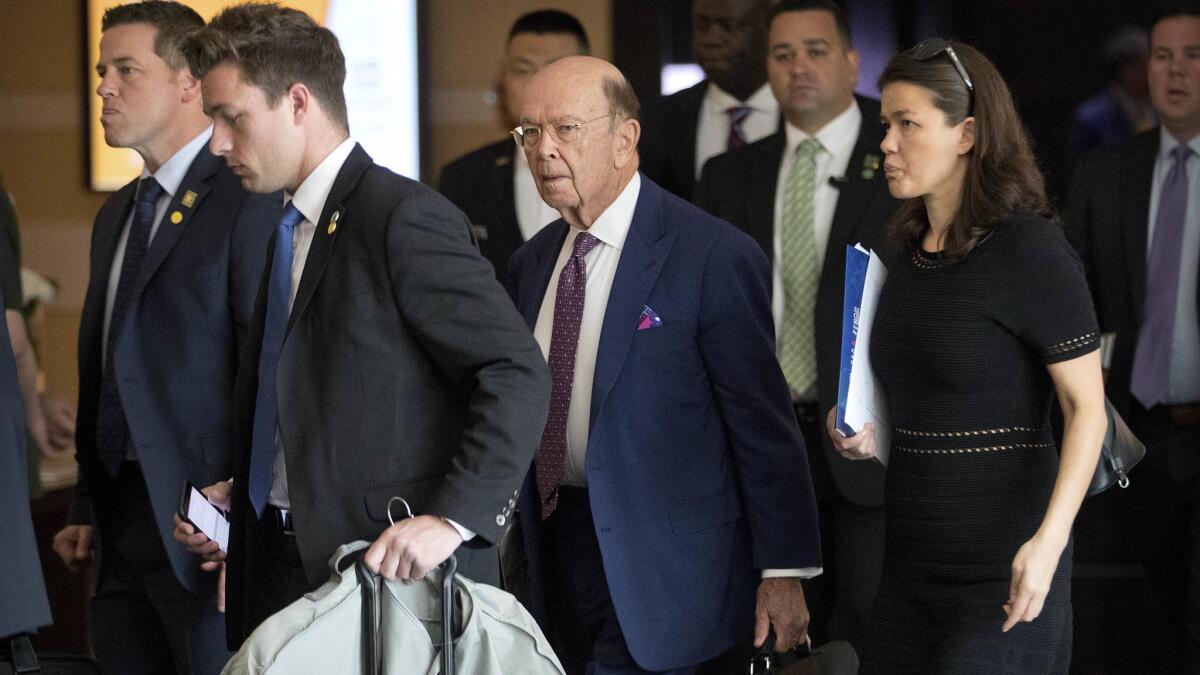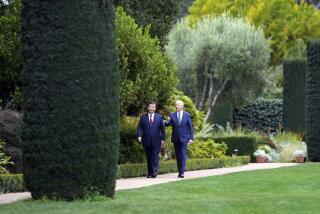Analysis: Trump team’s talks in China raise both questions and fears of a trade war

Even by President Trump’s unpredictable and bare-knuckles style of negotiating, his economic team’s visit to Beijing in recent days to confront China on trade was both bewildering and, for many in both countries and beyond, worrisome.
Worrisome because the two-day meeting that concluded Friday showed that the U.S. and China are miles apart, making the threat of a trade war very real. There was no joint communique afterward or any official word on when, or whether, they would meet again.
And bewildering because the indications are that the two sides talked past each other, with Trump’s high-level emissaries presenting an eight-point set of demands that analysts called so far-fetched that no country would accept it, let alone China — a rising superpower whose national pride is wrapped up in a historical narrative of overcoming century-long subjugation by foreign powers.
The U.S. demands, spelled out as a draft framework for negotiations, not only call for China to cut its $337-billion trade surplus with America by more than half, $200 billion, and immediately halt state support for President Xi Jinping’s signature Made in China 2025 industrial policy. But also, they say that Beijing must refrain from retaliating or filing legal challenges should the United States slap tariffs or investment restrictions on China.
“That’s a non-starter for any leader,” said Andy Rothman, an investment strategist at San Francisco-based Matthews Asia and former economic officer at the U.S. Embassy in Beijing.
Then why would Trump’s delegation of Cabinet members, including Treasury Secretary Steven T. Mnuchin, Commerce Secretary Wilbur Ross and the U.S. trade representative, Robert Lighthizer, present such an unrealistic set of demands?
Neither Rothman nor other analysts had an easy answer, except to say that it has become standard operating practice for Trump to keep allies and adversaries alike guessing, with surprising demands and threats of severe actions. Some of them, like Trump’s campaign promise to label China a currency manipulator right away, turned out to be bluster.
“It is hard to assess whether this was a kind of ‘fire and fury’ message intended to signal to the Chinese that they are dealing with a very serious situation,” said Claire Reade, a former assistant U.S. trade representative for China affairs.
“It is also possible that the U.S. side knew it was a complete non-starter, but used the proposal to detail China’s sins, demonstrate China won’t fix them and thereby further justify U.S. actions against China.”
The outlook is muddied by the president’s repeated praise of Xi, especially for ratcheting up economic pressure on North Korea and its leader, Kim Jong Un. Trump plans to meet with Kim by early June to discuss a denuclearization of the Korean peninsula, and the president would not want China to stand in the way of his achieving a historic breakthrough.
At the same time, the Trump administration — if not the president — has publicly cast China as an economic and military threat, an adversary like Russia. And to Beijing’s chagrin, the administration has taken steps to draw closer to Taiwan, an island that Beijing considers a renegade province.
On Saturday, the White House press secretary issued an unusually caustic statement denouncing as censorship and “Orwellian nonsense” Beijing’s recent demand that U.S. and other foreign airliners change how Taiwan, Hong Kong and Macau are identified on their websites, to make clear they are not independent entities.
On trade with China, Trump has been consistent in denouncing the Asian giant’s huge trade surplus with the United States and its mercantilist economic behavior. The administration has slapped tariffs on Chinese solar panels, steel and aluminum, and has prepared a list of other Chinese products worth about $50 billion that could be hit with tariffs as punishment for intellectual property theft and the forced transfer of technology to China by U.S. companies as a condition of doing business there.
After Beijing responded by proposing counter-tariffs of commensurate value on U.S. goods including soybeans, airplanes and cars, Trump immediately called for a possible tripling of the potential duties against Chinese goods.
“Trump is operating in ways no other president has in the past where there was a coherent strategy,” Rothman said.
That includes diplomatic protocol.
In a break from previous high-level meetings with the Chinese on trade and security matters, the Trump administration did not send an advance team to do groundwork before the delegation arrived. The White House did not hold the customary news briefing ahead of the trip. And administration officials left Beijing quietly, with the White House issuing a short statement saying they had “frank discussions.”
Late Friday, Trump tweeted that he would be conferring with his team Saturday “to determine the results, but it is hard for China in that they have become very spoiled with U.S. trade wins!” On Saturday, at an event in Ohio ostensibly to promote his tax cuts, the president spent much time attacking trade with China.
The Chinese, for their part, did not publicly mention the U.S. demands. The state-run New China News Agency reported that the two sides “reached consensus in some areas” but that “major differences” remained.
Chinese officials, led by Vice Premier Liu He, were expected to reiterate previously signaled offers from Beijing to cut tariffs on auto imports, ease up on some joint-venture requirements and open up its financial services sector. But during the talks, analysts said, Beijing apparently presented its own hard-line demands, that the U.S. relax restrictions on selling certain high-tech goods to China and drop recent sanctions against the Chinese telecommunications firm ZTE.
The post-meeting reaction from both sides may reflect a desire not to inflame tensions, but also spoke volumes about how far apart they are. Xi had been expected to meet with the delegation, but did not do so.
“We give them a list of things they will never do and they give us a list of things we will never do,” said David Loevinger, a former Treasury official on China affairs.
For the Trump administration, the reticence could also reflect the internal division among Trump’s top economic and trade officials. Mnuchin, who the White House statement said led the delegation, and Ross are thought to be more pragmatic. Lighthizer and trade advisor Peter Navarro, a China hawk, have been pushing a harder protectionist line against a country they regard as out to supplant American economic power.
Nobody was expecting a breakthrough or easy negotiations, but analysts say it’s still unclear what the administration’s primary goals are — whether to bring the trade deficit down, a near-obsession for Trump that would probably take years to achieve; to secure short-term market access in China; or to get Beijing to change its behavior and its policies — including Xi’s Made in China 2025 strategy — intended to achieve dominance in strategic technology and other high-value sectors.
Given Trump’s “America first” agenda to get tough on trade, the president is certain to want tangible results that he can hold up to his political base as fulfillment of his campaign promise. But just what he will deem acceptable is anybody’s guess.
Analysts and business people are betting that Trump may take China to the precipice of a trade war but not go over, to avoid hurting the U.S. economy and, in turn, his own political standing.
Rothman said he could see Trump just getting on the phone with Xi and saying, “Let’s do a deal.” Said Reade: “I suspect the U.S. delegation left China with next steps totally up in the air because Trump will call the shots here, and no one can predict what he wants.”
Follow me at @dleelatimes






